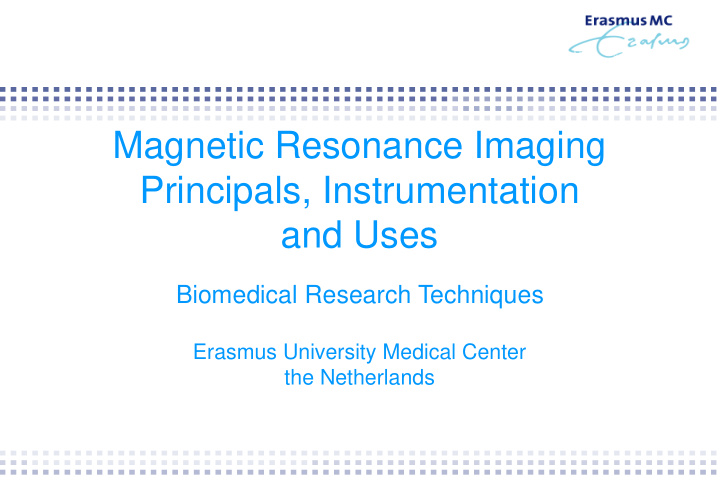



Magnetic Resonance Imaging Principals, Instrumentation and Uses Biomedical Research Techniques Erasmus University Medical Center the Netherlands
Aim The aim of the lecture is to obtain a basic understanding on MRI physics and instrumentation and further more to show how MRI is being used by researchers and clinicians Content Basic hardware in an MRI scanner Acquiring a 3D image Frequently used MRI applications
3 MR images of the same brain Non-invasive Ideal for longitudinal studies High information content Different contrast can be obtained using different MRI sequences Research and clinical setting
Clinical MRI scanner Earths magnetic field : 0.00005 Tesla Philips GE Siemens 1.5 T = 64 MHz 3.0 T = 128 MHz
Small animal experimental scanner 7 T = 300 MHz Agilent technology/ GE Healthcare
Basic parts of a scanner electronics / computer magnet gradient coils RF coils B 0 patient
Basic parts of a scanner Quadrature Head coil Surface coil
Behavior of spin in magnetic field B 0 nuclear spin makes compass aligns in precession movement in magnetic field magnetic field
Precession Precession frequency Larmor frequency Gyromagnetic ratio ( 42.56 MHz/T for proton )
Energy transfer It is possible to transfer energy to the Hydrogen nuclei through a radiofrequent pulse M, B0 M
The origin of the NMR signal RF-coil = loop of wire Precession of spins induces current in the RF-coil Origin of the MRI signal is an induction current or voltage
Relaxation 2 principles of relaxation, T1 and T2 z y y x,y x x dephasing T2 T1
T 1 relaxation 1 / t T ( 1 ) M M e M z 1 0 0 0 10 time (s) T 1 relaxation = increase of magnetization along z-axis Energy transfer (from ? to?)
T1 contrast T 1 = 1500 ms T 1 = 1000 ms S TR Faster relaxation for tissues with lower T 1 higher signal
T 2 relaxation 1 t / T M e 2 M xy XY 0 200 time (ms) T 2 relaxation = dephasing of magnetization in xy-plane
T 2 Contrast T 2 = 100 ms T 2 = 50 ms S TE Faster relaxation for tissues with lower T 2 lower signal
Relaxation is tissue dependent The origin of the relaxation lies in molecular motion and interactions of water with other molecules TISSUE T1 (ms) at 1.5T T2 (ms) muscle 870 47 liver 490 43 kidneys 650 58 spleen 780 62 lipid 260 84 gray matter 920 101 white matter 790 92 CSF >4000 >2000 lung tissue 830 79
Contrast due to differences in relaxation proton density T 2 weighted T 1 weighted Contrast can be obtained by making the MRI acquisition sensitive to differences in relaxation times
Imaging Task: find a unique signal for each 3D position (x,y,z) What is the water density in each voxel (x,y,z) ?
Magnetic field gradients The solution : RF in combination with Magnetic Field Gradients RF coils Gradients
Spatial localization The solution : Give each position its own unique Larmor frequency B 0 B=B 0 + G x x Frequency and phase of the signal can be used for encoding
Localization in 3 dimensions 3 main gradient fields G x = dB/dx G y = dB/dy G z = dB/dz [G]=T/m
Acquiring information from a voxel Apply the slice selection gradient during RF excitation Phase encoding consists of a gradient that changes the phase within the slice Frequency encoding is applied during the signal readout Together this consists of a multitude of frequencys that are spinning with a certain phase difference
Sequences
Neurology Pathology Tumor detection MS lesions Alzheimers disease Functionality fMRI Diffusion Tensor Imaging (DTI)
Neurology Pathology Tumor detection
Neurology Pathology MS lesions
Neurology Functionality fMRI
MRI – diagnosis Functional MRI (fMRI) Measures oxygen consumption volunteer 1: move feet volunteer 2: move hands volunteer 3: pucker lips Courtesy, Marion Smits, Radiology
Neurology - Preclinical Brain Imaging Rat
Cardiology
Cardiology
Cardiology MR Angiography Peripheral arterial disease Patient with chronic critical ischemia www.radiologyassistant.nl
Cardiology Cardiac Imaging Rat Angiography Mouse
Oncology Tumor detection Characterization Pathology
Oncology Tumor detection
Oncology Tumor detection
Oncology Tumors: dynamic contrast enhancement Malignancy Malignancy www.radiologyassistant.nl
Tumor Characterization
Orthopedic use Traumatic joint injuries Torn Cruciate Ligament Torn Meniscus Torn Labrum contrast enhanced Courtesy Edwin Oei, Radiology
Cell tracking In vitro single cell tracking RI
Additional reading e-MRI : Magnetic Resonance Imaging physics and technique course on the web ( http://www.e-mri.org/ ) The basics of MRI, free on-line introductory MRI course ( www.cis.rit.edu/htbooks/mri/ ) Magnetic Resonance Imaging: Physical Principles and Sequence Design E. Mark Haacke, Robert W. Brown, Michael R. Thompson, Ramesh Venkatesan Magnetic Resonance Imaging Marinus T. Vlaardingerbroek, Jacques A. den Boer, F. Knoet Handbook of MRI Pulse Sequences Matt A. Bernstein, Kevin F. King, Xiaohong Joe Zhou
Special thanks to Gyula Kotek Piotr Wielopolski Gustav Strijkers Ramon van der Werf Monique Bernsen Edwin Oei
Questions?
Recommend
More recommend